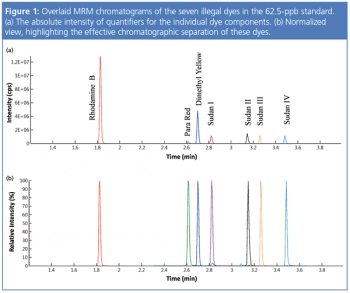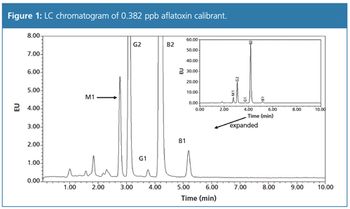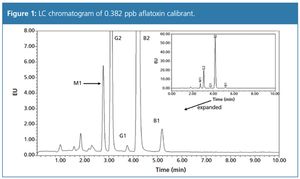Articles by Wilhad Reuter

Synthetic azo- and non-azo dyes were once commonly used as food colourings in many countries. Food safety regulators in Europe, the U.S, and other countries have now banned the use of these synthetic dyes in food because of their potential genotoxic and carcinogenic effects. In some countries, however, these dyes are still being used, especially in spices. There are currently no published legal limits for these illegal food dyes, but any detectable amount is deemed unacceptable. Thus, any analytical method used to test foods for these illegal dyes must be highly sensitive. Conventional methods are only able to provide limits of quantitation (LOQs) of 10–1000 ppb for these illegal food dyes. A reversed-phase ultrahigh-pressure liquid chromatography tandem mass spectrometry (UHPLC–MS/MS) method has been developed that reliably achieves LOQs that are three-to-four orders of magnitude lower than conventional methods while also providing improved accuracy and reproducibility.

This article highlights the analytical advantages of analyzing raw milk for aflatoxins, focusing on M1, using high performance liquid chromatography (HPLC) with fluorescence detection - without derivatization. Leveraging M1’s native fluorescence, this is particularly welcome since this approach affords the requisite analytical sensitivity with minimal method complexity.

All plant foods are complex mixtures of chemicals including both nutrients and biologically active non-nutrients, referred to as phytochemicals. Soy is known for having high concentrations of several physiologically-active phytochemicals, including isoflavones, phytate (inositol hexaphosphate), saponins, phytosterols and protease inhibitors. The isoflavones are what makes soy unique.

Polynuclear aromatic hydrocarbons (PAHs) are carcinogenic condensed ring aromatic compounds widely found as trace pollutants in waters, wastes, air particulates, soil and foods. PAHs can be routinely monitored using HPLC with a combination of UV and fluorescence detection as prescribed in EPA methods 550.1, 610 and 8310.

Very low level detection of mycotoxins in the agriculture products has become increasingly important. Mycotoxins are very resistant fungal metabolites that can remain in foods after processing and, sometimes, even after cooking. They are considered potent carcinogens and can be found in many varieties of foods. Of the mycotoxin class, aflatoxins are considered especially harmful, being both acutely and chronically toxic. Aflatoxin B1 and B2 are some of the most potent hepatocarcinogens known. Along with aflatoxins G1 and G2, even extremely low levels of these aflatoxins in the diet are important public-health concerns. With this in mind, this application note describes a specific, robust HPLC method for the low-ppb detection of aflatoxins B1, B2, G1 and G2 in corn.










